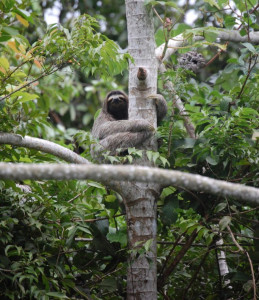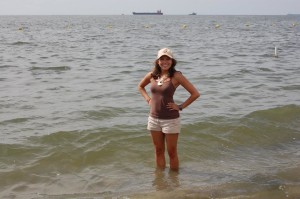 |
| Panama City (Photo Cred: Lindsay Amanda) |
For many, crossing the Panama Canal is on the bucket list. Its historical importance and ingenious engineering has designated it as one of the wonders of the world. It not only honors the development of the modern age, but also gives tribute to the many lives that were lost during the time of its construction.
The crossing began early in the morning around 5 am local time. I must admit that I was still in recovery mode from the excitement of the day before in Costa Rica and slept through the most anticipated and reportedly the most impressive first lock. I enjoyed a relaxing day in the canal and laid by the pool drifting in and out of sleep while peacefully cruising down the passage. I did spend a considerable amount of time admiring the incredibly lush vegetation that lined the Panamanian shores. I was surprised by how murky the brown water was, an earthy compliment to the trees that surrounded it.
We traveled under the Bridge of the Americas that connects Central and South Americas by transit and sailed across the continental divide. I was able to experience the third lock on our way to the pacific side, which I later viewed from an all encompassing perspective when I took a land excursion of the Gatun Lake and Locks. I did get the reminder that the world is in constant change when I found that the three original locks will eventually be replaced by two new designs. Knowing that the originals have an expiration date in my lifetime gives a special significance to the experience.
Once we cleared the canal we ported off shore near the small town of Fuerte Amador on Flamenco Island. It is only 30 miles away from Panama City, which we could see clearly from where we anchored. It was an awesome view and reminded me very much of the skyline of Chicago. I explored the small town with my ship friends, now newlyweds, but not much was going on in the local retirement community. We all regret not taking a taxi into the city, but we all could imagine how exciting it looked at night with the lights glittering from across the bay.
The excursion the next day brought us, as mentioned, to Gatun Lake and Locks. Driving through the countryside I saw the familiar fertile landscape that is so characteristic of the region. Although I loved it, it did make me sad to see the amount of trash and litter left along the sides of the roads and highways, I could not help but think that my own country would not allow such pollution to occur. The lake is actually man made, and the islands that sprung from the water were simply hilltops that previously stood tall above the ground below. We rode along the coast of the lake and although I have yet to see a monkey, I did get a glimpse of three sloths hanging idly in the trees which I was really excited for.
In reflection, I really did find this time special. I may have taken it for granted slightly as a simple path that was guiding me to my destination, but I truly appreciate the memory in full. I thank the Panamanian people for their hospitality and can say that despite living in some of the more impoverished areas, the happiness that shines on the people’s faces are inspiring and uniquely memorable.
















